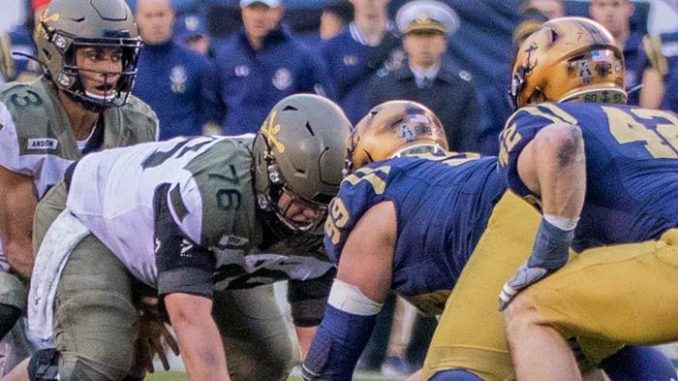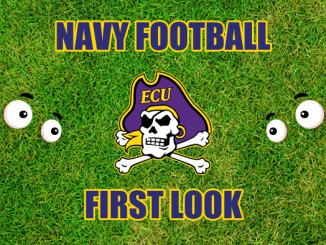
It was the central story of the 2019 Army-Navy Game – not the only story, but the main one: Would Malcolm Perry finally beat Army?
Perry rushed for 250 yards against Army in 2017. He was clearly the best player on a snowy field in Philadelphia, but two late false starts by Navy created a much tougher field goal than the Midshipmen were expecting. A well-struck kick just under 50 yards away drifted wide of the left upright. Navy absorbed a very painful loss, the kind of loss Army had endured all too many times during the Black Knights’ 14-game losing streak to the Midshipmen.
The end of the 2017 game showed that having the better quarterback didn’t guarantee victory for Navy. The magic of the 14-game winning streak over West Point was going to run out at some point. The 2016 game broke the 14-game streak, but the 2017 game showed that Navy couldn’t rely on the ball bouncing the right way in the fourth quarter.
In 2018, Army was comprehensively better, and Navy’s offensive line was nowhere near the level it needed to attain victory over West Point. The athletes from Annapolis watched Army win a third straight Army-Navy Game and then collect an 11th win in the bowl season. Three years earlier, in 2015, it was Navy which extended a winning streak against Army and then notched win No. 11 in the bowl game.
As the 2019 service-academy football season began, people in Annapolis weren’t wondering if Navy was going to win 10 games with a chance at 11; people were wondering if Army was going to launch a period of long-term dominance in the Commander In Chief’s Trophy series.
Jeff Monken had so thoroughly and completely flipped the script in the CIC Trophy battle. In a few short years, the Black Knights did more than merely stop the 14-year “Naval Blockade” in December; they shoved Navy to the bottom of the CIC pecking order and rose to the heights Navy had recently attained in the 2015 season under quarterback Keenan Reynolds. This was more than Army getting better; Army orchestrated a complete 180-degree shift.
When the balance of power changes as dramatically as it did between 2015 and 2018 in academy football, questions get asked. Doubts emerge. Navy’s future – which once seemed as reliable and reassuring as the sun rising in the east – fell under dark clouds for the first time in the Ken Niumatalolo era.
The aberrational non-bowl season of 2011 felt like a blip for the Mids, in part because weird events helped sabotage that particular Navy football year. Recall the absurd 15-yard penalty against Navy quarterback Kriss Proctor in overtime, leading to a 35-yard PAT which was blocked, giving Air Force the one-point win. Navy had that “one bad season” in 2011, a year in which the laws of averages simply didn’t line up on Navy’s side.
The 2018 season was a lot worse than 2011. After a 6-6 regular season in 2017, Navy bottomed out, falling to 3-10 and looking a lot like the Army teams which constantly fell short against Navy in the 14-game streak from 2002 through 2015. No, Navy football wasn’t going to remain awful every year, but would it become especially good again? That was a legitimate question in 2019 after seeing the 2018 season unfold.
The idea that Navy would be a 6-6 or 7-5 program once again was reasonable and – I don’t think – deeply questioned in and around Annapolis. However, that wasn’t the big question for the Midshipmen entering 2019. The question was if “Navy as we have known it” – a program which often won nine games in a season – would return.
It was reasonable to think that after a 3-10 season in 2018, Navy would need two years to build back to the nine-win standard Navy reached in three of four seasons from 2013 through 2016. Army, meanwhile, had won 10 or more games in two straight seasons. Given that Air Force had surprisingly endured two straight losing regular seasons in 2017 and 2018 – the first time the Falcons had suffered such a setback under coach Troy Calhoun – the idea of a sustained Army ascendance in academy football was not a ridiculous notion.
In a few years, West Point had overturned everything we had known about 21st-century academy football.
Winning 10 games wasn’t Navy’s main goal this year. Merely restoring a sense of confidence and reestablishing a winning identity were the realistic targets for this team. An 8-4 season would have sounded absolutely fantastic before 2019 began. The one goal which really mattered was the obvious one: Beat Army.
The goal was to get Malcolm Perry that elusive win over West Point. Navy needed to break the chains imposed by the Black Knights. That one achievement would create a distinct feeling of renewal in and around Annapolis.
As the Midshipmen celebrate a blowout win over Army – providing the Army-Navy Game’s first margin of more than seven points since 2013 – the reality for Navy is better than it ever could have imagined on Labor Day weekend, three months ago.
Not only has Perry beaten Army, he has set the career rushing record for any player in the Army-Navy Game, with 606 yards. Not only did Perry set that career record, he set the single-game Army-Navy rushing record with 304 yards. Not only did Perry set that record, he became the first Navy player to rush for 300 yards in a game against an FBS opponent.
Remember: Navy has produced two Heisman Trophy winners, Joe Bellino and Roger Staubach. The Army-Navy Game has produced college football icons such as Doc Blanchard and Glenn Davis.
Malcolm Perry stands above them all in career Army-Navy yards and single-game Army-Navy yards. Perry also set the new single-season rushing yard record, passing another Navy great, Napoleon McCallum.
Perry beat Army… and achieved literally dozens of other milestones (several others not mentioned here) in the process. Perry got his treasured win over West Point… and stamped himself as a Navy football legend with an undeniably immortal performance in the annals of Army-Navy lore.
Malcolm Perry got his win over the Black Knights. That alone is more than enough to satisfy a world-class competitor whose fourth-quarter heroics stood at the center of a 10-win regular season for Navy which has surpassed the most optimistic September hopes and expectations. Yet, even while transcending so many expectations this year, Perry transcended our collective awareness of what was possible in the 2019 Army-Navy Game.
Rarely has one Army-Navy performance made one person’s career so complete.
Commodore Perry commands the oceans today.




Be the first to comment